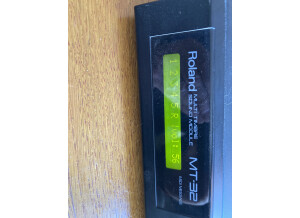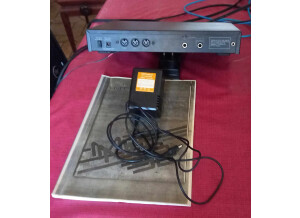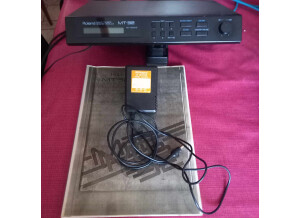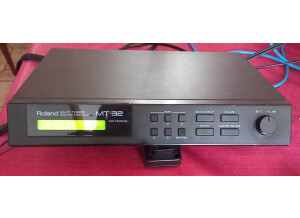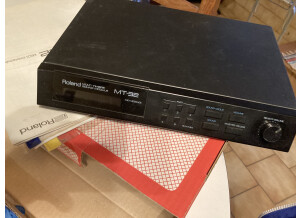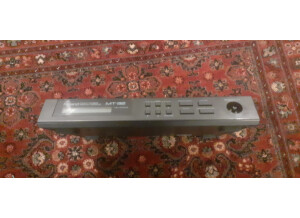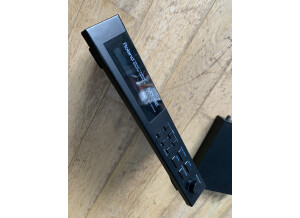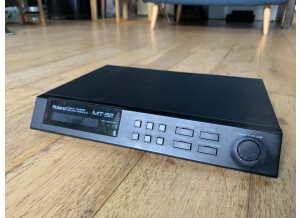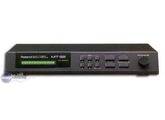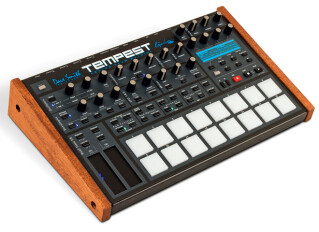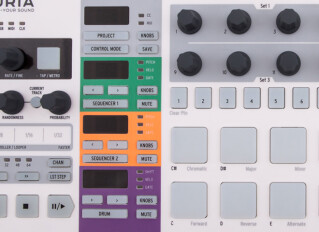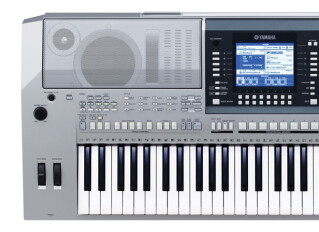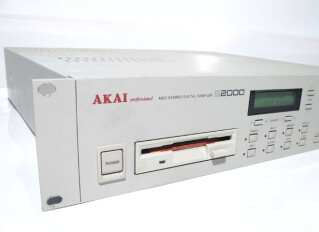MT-32 classified ad
Alerte nouvelle annonceImages
Reviews
5.0/5(1 reviews)
100 %
Write a user review
Published on 02/17/06 at 12:30 (This content has been automatically translated from French)
The MT-32 is a small MIDI compatible sound module released in 1987. Sharing the same technology as the famous Sound Roland D-50 from the same period (Linear Arithmetic synthesis, combining synthetic waveforms to real samples of musical instruments in PCM), it was considered at the time, more as a MIDI sound card high-end as a full MIDI expander.
Indeed, many PC games of that time, particularly those of Sierra (The Secret of Monkey Island, Leisure Suit Larry, King Quest ...) who proposed to reproduce their soundtrack through the synthesizer instead of MIDI synthesis AdLib, technology much less powerful (as composed solely of synthetic sounds FM), but also much more affordable, at a...…
Indeed, many PC games of that time, particularly those of Sierra (The Secret of Monkey Island, Leisure Suit Larry, King Quest ...) who proposed to reproduce their soundtrack through the synthesizer instead of MIDI synthesis AdLib, technology much less powerful (as composed solely of synthetic sounds FM), but also much more affordable, at a...…
Read more
The MT-32 is a small MIDI compatible sound module released in 1987. Sharing the same technology as the famous Sound Roland D-50 from the same period (Linear Arithmetic synthesis, combining synthetic waveforms to real samples of musical instruments in PCM), it was considered at the time, more as a MIDI sound card high-end as a full MIDI expander.
Indeed, many PC games of that time, particularly those of Sierra (The Secret of Monkey Island, Leisure Suit Larry, King Quest ...) who proposed to reproduce their soundtrack through the synthesizer instead of MIDI synthesis AdLib, technology much less powerful (as composed solely of synthetic sounds FM), but also much more affordable, at a time when sound cards like Sound Blaster just beginning to become more democratic in the PC.
The expander, because of its rather unique position in the market, not to my knowledge, a model "rack" as is. Compatible with MIDI, however, there are three MIDI standard round (In, Out, Through) and can reproduce up to 8 instruments simultaneously on eight MIDI channels (channels 2-9) and a percussion track on channel 10. Its maximum polyphony is four waves / sound samples per instrument, which makes us a total of 8 instruments x = 4 components polyphony 32 "notes" simultaneously, hence the name "multi-timbral 32". Level effects, there is only one, the essential reverb, whose intensity is adjustable to a level of 0 (no reverb) to 10 (maximum reverb). Regarding the audio connections, a MT-32 offers two basic female output jacks to 6.35 mm format, right and left / mono. On some newer MT-32, a headphone jack has also made its appearance.
It offers 128 sounds, but not compatible with the General MIDI standard, which appeared in 1991, four years after its release. 128 These sounds are organized into categories, however, similar to those of General MIDI (pianos, organs, synthetic chromatic, guitar, percussion), but like any good MIDI device, it is possible to reorganize these sounds via SysEx files specific to to make the MT-32 partially compatible with General MIDI. Partly because, as noted above, it can only play eight channels at once plus the percussion channel, compared to 16 channels of MIDI today. The percussion track (there is only one drum kit standard), by contrast, is organized pretty much like the General MIDI: bass drums, snares, toms, cymbals ... Unfortunately, all the drum sounds of General MIDI are not present on the trail of percussion of the MT-32, is missing, for example, some wood blocks or cymbal.
The sounds can be edited and reorganized through SysEx files, you can create with specific utilities, enough of the time (and still present today on the Internet), DOS or Windows. My choice was "LA Synth Editor", originally designed for Windows 3.x but works great on Windows XP SP2, and offers an excellent bank of hundreds of custom sounds. The sound editing is quite complex in most cases, but as with everything, it's a matter of habit. Relatively versatile, the MT-32 has a limitation, however frustrating for editing sounds, you can only store 64 custom sounds, in addition to existing 128 (bringing the maximum number of sounds used to 192), and you will not have access to these 64 additional sounds from the device or a MIDI keyboard, without re-assign these instruments in place, for example, first 64 original instruments.
To my knowledge, no extension is available for the MT-32, since it does not provide location to accommodate expansion cards. However, some specialized companies offered at the time, to make hardware changes on the MT-32, in order to blow up some of its limitations or improve its functionality (battery backup, additional audio outputs ...) , changes best known as the "RealWorld", but find a modified MT-32 in good condition is becoming more difficult today, and I doubt that companies were making these changes there are more than fifteen years still willing to do so today!
UTILIZATION
The MT-32 sound module is ideal for beginners with this type of synthesizers, as it is very easy to use. It has an LED that lights up when the flow of MIDI data within the device, its LCD display 1 line of 20 characters constantly shows the status of the MIDI tracks which reproduces the notes, and it offers facade various buttons for setting parameters such as the master volume, the instrument cluster, instrument and the volume of each MIDI channel 8 and channel played percussion.
If these settings are available either for the first five channels and the percussion channel (each channel has a control button), it will make an extra step to access the settings for channels 6-8. A trifle tedious at first (direct buttons for these channels were not too many), the key combinations quickly become familiar, especially since most of them are done by holding down the Master Volume: access to channels 6-8 (holding that key and pressing 1, 2 or 3), reverb level adjustment, reset the device, adjusting the amount of reverb, etc..
The manual is fairly well (you can find it scanned in PDF format on the internet if you can not get a TM-32 with its printed documentation), details the manipulations that can be carried out and technical parameters to better understand the editing sounds. After a first reading, it becomes very easy to manipulate this device, which, I repeat, is certainly one of the simplest sound modules available.
But this device is of course not free of defects.
Thus, the custom settings (including the sounds that you have published) are not kept to the extinction of the device, so you have to remember to save a SysEx file that you should charge for each power.
The volume knob, which serves as navigation button is looking pretty robust, but it should be handled in a way, because not notched, it can not rotate on itself; Thus, for example, if a MIDI file to set the volume of the device at a volume lower than that indicated by the position of the button, you will need to return the button back in order to increase the volume level c ' is a reflex to acquire, but not always easy to manage.
And last, but it is a defect understandable given the age and market positioning of the device, the MT-32 product a little breath. Breath, for one, does not bother me absolutely not, especially in reading, but can interfere when recording, especially if you record the sound at low volume and that it normalizes sound levels of the sample more.
SOUNDS
The sounds of the MT-32 have a rather unique color, nor really sound, not too synthetic, more appropriate, in my opinion, for the reproduction of MIDI files.
This is probably the reason he has not really been used in musical productions in the late 80's - its big brother, the D-50, was already a place in this area - but in the greatest PC games of that time: Sierra (The Secret of Monkey Island, Day of The Tentacle ...), Westwood Studios (The Legend of Kyrandia, Loom ...) or Delphine Software (Les Voyageurs du Temps, Operation Stealth) are among the few publishers / developers of video games that included a support of the MT-32 in their productions of the time, to give players (and wealthy fans) who could afford at the time this unit or his classmates compatible (sound card LAPC-I, CM-32/64, MT-100, CM-500 ...), a better gaming experience to the sound level, the MT-32 can reproduce both music and sound effects games in place of its chipsets compatible AdLib present at the time of the most common sound cards and cheaper, like the Sound Blaster.
In terms of realism, as in any synthesizer, there is good and less good, and this is of course subjective.
The best sounds are, in my opinion, the synthetic sounds: organs, tablecloths, low ... Many have a pretty amazing punch for such a small machine (Organ 2, Doctor Solo, Square Wave ...), and some instruments are very similar if not identical to those of the famous D-50: pads (Atmosphere, Fantasia, SoundTrack. ..), the color (Marimba, Vibraphone ...) or the flute (especially the shakuhachi).
The sounds are the worst, in my opinion, those to come as close as possible to the equivalent acoustic pianos (except electric pianos, designed to have a sound electrical and Honky-Tonk, which, although synthetic, no shortage of fishing), some sheets and strings acoustic solo (harp, Pizzicato) and acoustic guitars and basses, sounding almost all synthetic, with the exception of the low "slap".
The only exception in terms of acoustic instruments, percussion. I find them really good, and yet I am used to big sounds good nag. The drum sounds are the MT-32 all-purpose, expressive and suitable for any style of music. I find them better than the bank's standard percussion MIDI synth comes with Windows (which itself is based on sound bank Roland SCC-1).
Connected to my modest master keyboard Evolution MK-249 (via its MIDI out), the MT-32 responds well to velocity, I find that the modulation is quite low compared to other MIDI synths (I think of my synths Sound Blaster Live!), and the pitch bend is different from the standard General MIDI (GM on a synth, push the pitch wheel will shift back to the sound of some notes, while the same intensity causes a shift of an octave on the MT-32), but most of these parameters are adjustable SysEx files.
The best way to get an idea of the MT-32 sounds is to listen to recordings (MP3, OGG) audio tapes of video game format MT-32, in addition to those I already mentioned earlier, I TFX also cite (using custom sounds good, including electric guitars synthetic simply amazing for such a machine) or SimCity 2000.
OVERALL OPINION
My story with this synth is very special. I purchased second-hand in March 2005 to a member of AudioFanzine for € 45, with its original power cables and MIDI / audio, but without paper documentation. Big problem, it produced a constant background noise extremely unpleasant. I tried for almost a year to solve this problem without success (changing diet, audio cables, dismantling and cleaning the motherboard, change it by a newer model that is m 'had graciously offered).
Annoyed by this intractable problem, I tried to sell it, in view of reprocurer me another copy (with the intention to test it locally before you buy), but a member of the community-MT 32 most active Web Quest Studios ( http://www.queststudios.com ) , kindly offered me to exchange my defective MT-32 against the model in good condition, convinced that he could easily solve the noise problem with my MT-32. So I can only thank him warmly for his action, for it is through him that I can now really enjoy the MT-32 for old DOS games or to complete my sound bank SoundFont.
This is my first MIDI sound module (I have a Sound Blaster Live! And a MIDI master keyboard MK-249). I love this little machine for its ease of use and price / quality ratio. Can be found today in the MT-32 € 30 on the internet or in some stores to sell used equipment, a price I can not find at all high, compared with $ 600 that it was, I appears at its output, which made little accessible to anyone wishing to improve the sound quality of their games, at a time when a Sound Blaster "basic" was argued, if I remember correctly, in the 150 € (1000 F).
I would do if I had the choice to acquire a MIDI device in this price range, because the MT-32 is certainly the most versatile compared to its peers compatible, CM-32/64, LAPC-I and other CM-500. If it does perhaps not sound the same opportunities that they (the CM-500, for example, combines the sounds of the MT-32 and sounds of the SC-55), the MIDI connection has maintained consistent with all the musical equipment of today (unlike the LAPC-I, version "internal sound card" of the MT-32, which is impossible to get into port without a PC ISA, replaced for years by the PCI) . Moreover, its screen and control buttons are more real compared to LAPC-I or CM series, which are not fitted to my knowledge.
It should, in order not to be disappointed with this device, to clearly define its positioning and the use that was made: it is the instrument of choice for any player PC in the late 80's and early 90 years, because of the number of video games that have used music and sound capabilities, so brilliant for some of them I already mentioned.
However, it may disappoint someone looking for the big sound characteristics of the time, that would be more interested in the D-50 for example, a model with the same sound technology, "LA", but with parameters publishing more advanced. It must indeed say that, even in comparison with the musical material of the time, the MT-32 has no sound capabilities and highly technical, even if we can convert it partially to the General MIDI, as a lot of basic sounds are interesting and that we can draw some very good synth sounds with minimal effort editing.
If so I can give you advice as a conclusion to this long article, check up on the capabilities and usability of this device, to ensure the best fit with your needs, the Forum Quest Studios website is an excellent source of information for that. Pay attention to the nature of the occasion on which you will fall, if you buy a machine of this age, to avoid being trapped (e) like me with a priori model in good condition, but ultimately failed because it would seem that such machines tend to deteriorate with age (see the problems with the contacts of carbon D-50) especially if not maintained properly.
With that, I hope that this notice you will know enough about this small expander, I stand at least at your disposal for any comments on this article!
Indeed, many PC games of that time, particularly those of Sierra (The Secret of Monkey Island, Leisure Suit Larry, King Quest ...) who proposed to reproduce their soundtrack through the synthesizer instead of MIDI synthesis AdLib, technology much less powerful (as composed solely of synthetic sounds FM), but also much more affordable, at a time when sound cards like Sound Blaster just beginning to become more democratic in the PC.
The expander, because of its rather unique position in the market, not to my knowledge, a model "rack" as is. Compatible with MIDI, however, there are three MIDI standard round (In, Out, Through) and can reproduce up to 8 instruments simultaneously on eight MIDI channels (channels 2-9) and a percussion track on channel 10. Its maximum polyphony is four waves / sound samples per instrument, which makes us a total of 8 instruments x = 4 components polyphony 32 "notes" simultaneously, hence the name "multi-timbral 32". Level effects, there is only one, the essential reverb, whose intensity is adjustable to a level of 0 (no reverb) to 10 (maximum reverb). Regarding the audio connections, a MT-32 offers two basic female output jacks to 6.35 mm format, right and left / mono. On some newer MT-32, a headphone jack has also made its appearance.
It offers 128 sounds, but not compatible with the General MIDI standard, which appeared in 1991, four years after its release. 128 These sounds are organized into categories, however, similar to those of General MIDI (pianos, organs, synthetic chromatic, guitar, percussion), but like any good MIDI device, it is possible to reorganize these sounds via SysEx files specific to to make the MT-32 partially compatible with General MIDI. Partly because, as noted above, it can only play eight channels at once plus the percussion channel, compared to 16 channels of MIDI today. The percussion track (there is only one drum kit standard), by contrast, is organized pretty much like the General MIDI: bass drums, snares, toms, cymbals ... Unfortunately, all the drum sounds of General MIDI are not present on the trail of percussion of the MT-32, is missing, for example, some wood blocks or cymbal.
The sounds can be edited and reorganized through SysEx files, you can create with specific utilities, enough of the time (and still present today on the Internet), DOS or Windows. My choice was "LA Synth Editor", originally designed for Windows 3.x but works great on Windows XP SP2, and offers an excellent bank of hundreds of custom sounds. The sound editing is quite complex in most cases, but as with everything, it's a matter of habit. Relatively versatile, the MT-32 has a limitation, however frustrating for editing sounds, you can only store 64 custom sounds, in addition to existing 128 (bringing the maximum number of sounds used to 192), and you will not have access to these 64 additional sounds from the device or a MIDI keyboard, without re-assign these instruments in place, for example, first 64 original instruments.
To my knowledge, no extension is available for the MT-32, since it does not provide location to accommodate expansion cards. However, some specialized companies offered at the time, to make hardware changes on the MT-32, in order to blow up some of its limitations or improve its functionality (battery backup, additional audio outputs ...) , changes best known as the "RealWorld", but find a modified MT-32 in good condition is becoming more difficult today, and I doubt that companies were making these changes there are more than fifteen years still willing to do so today!
UTILIZATION
The MT-32 sound module is ideal for beginners with this type of synthesizers, as it is very easy to use. It has an LED that lights up when the flow of MIDI data within the device, its LCD display 1 line of 20 characters constantly shows the status of the MIDI tracks which reproduces the notes, and it offers facade various buttons for setting parameters such as the master volume, the instrument cluster, instrument and the volume of each MIDI channel 8 and channel played percussion.
If these settings are available either for the first five channels and the percussion channel (each channel has a control button), it will make an extra step to access the settings for channels 6-8. A trifle tedious at first (direct buttons for these channels were not too many), the key combinations quickly become familiar, especially since most of them are done by holding down the Master Volume: access to channels 6-8 (holding that key and pressing 1, 2 or 3), reverb level adjustment, reset the device, adjusting the amount of reverb, etc..
The manual is fairly well (you can find it scanned in PDF format on the internet if you can not get a TM-32 with its printed documentation), details the manipulations that can be carried out and technical parameters to better understand the editing sounds. After a first reading, it becomes very easy to manipulate this device, which, I repeat, is certainly one of the simplest sound modules available.
But this device is of course not free of defects.
Thus, the custom settings (including the sounds that you have published) are not kept to the extinction of the device, so you have to remember to save a SysEx file that you should charge for each power.
The volume knob, which serves as navigation button is looking pretty robust, but it should be handled in a way, because not notched, it can not rotate on itself; Thus, for example, if a MIDI file to set the volume of the device at a volume lower than that indicated by the position of the button, you will need to return the button back in order to increase the volume level c ' is a reflex to acquire, but not always easy to manage.
And last, but it is a defect understandable given the age and market positioning of the device, the MT-32 product a little breath. Breath, for one, does not bother me absolutely not, especially in reading, but can interfere when recording, especially if you record the sound at low volume and that it normalizes sound levels of the sample more.
SOUNDS
The sounds of the MT-32 have a rather unique color, nor really sound, not too synthetic, more appropriate, in my opinion, for the reproduction of MIDI files.
This is probably the reason he has not really been used in musical productions in the late 80's - its big brother, the D-50, was already a place in this area - but in the greatest PC games of that time: Sierra (The Secret of Monkey Island, Day of The Tentacle ...), Westwood Studios (The Legend of Kyrandia, Loom ...) or Delphine Software (Les Voyageurs du Temps, Operation Stealth) are among the few publishers / developers of video games that included a support of the MT-32 in their productions of the time, to give players (and wealthy fans) who could afford at the time this unit or his classmates compatible (sound card LAPC-I, CM-32/64, MT-100, CM-500 ...), a better gaming experience to the sound level, the MT-32 can reproduce both music and sound effects games in place of its chipsets compatible AdLib present at the time of the most common sound cards and cheaper, like the Sound Blaster.
In terms of realism, as in any synthesizer, there is good and less good, and this is of course subjective.
The best sounds are, in my opinion, the synthetic sounds: organs, tablecloths, low ... Many have a pretty amazing punch for such a small machine (Organ 2, Doctor Solo, Square Wave ...), and some instruments are very similar if not identical to those of the famous D-50: pads (Atmosphere, Fantasia, SoundTrack. ..), the color (Marimba, Vibraphone ...) or the flute (especially the shakuhachi).
The sounds are the worst, in my opinion, those to come as close as possible to the equivalent acoustic pianos (except electric pianos, designed to have a sound electrical and Honky-Tonk, which, although synthetic, no shortage of fishing), some sheets and strings acoustic solo (harp, Pizzicato) and acoustic guitars and basses, sounding almost all synthetic, with the exception of the low "slap".
The only exception in terms of acoustic instruments, percussion. I find them really good, and yet I am used to big sounds good nag. The drum sounds are the MT-32 all-purpose, expressive and suitable for any style of music. I find them better than the bank's standard percussion MIDI synth comes with Windows (which itself is based on sound bank Roland SCC-1).
Connected to my modest master keyboard Evolution MK-249 (via its MIDI out), the MT-32 responds well to velocity, I find that the modulation is quite low compared to other MIDI synths (I think of my synths Sound Blaster Live!), and the pitch bend is different from the standard General MIDI (GM on a synth, push the pitch wheel will shift back to the sound of some notes, while the same intensity causes a shift of an octave on the MT-32), but most of these parameters are adjustable SysEx files.
The best way to get an idea of the MT-32 sounds is to listen to recordings (MP3, OGG) audio tapes of video game format MT-32, in addition to those I already mentioned earlier, I TFX also cite (using custom sounds good, including electric guitars synthetic simply amazing for such a machine) or SimCity 2000.
OVERALL OPINION
My story with this synth is very special. I purchased second-hand in March 2005 to a member of AudioFanzine for € 45, with its original power cables and MIDI / audio, but without paper documentation. Big problem, it produced a constant background noise extremely unpleasant. I tried for almost a year to solve this problem without success (changing diet, audio cables, dismantling and cleaning the motherboard, change it by a newer model that is m 'had graciously offered).
Annoyed by this intractable problem, I tried to sell it, in view of reprocurer me another copy (with the intention to test it locally before you buy), but a member of the community-MT 32 most active Web Quest Studios ( http://www.queststudios.com ) , kindly offered me to exchange my defective MT-32 against the model in good condition, convinced that he could easily solve the noise problem with my MT-32. So I can only thank him warmly for his action, for it is through him that I can now really enjoy the MT-32 for old DOS games or to complete my sound bank SoundFont.
This is my first MIDI sound module (I have a Sound Blaster Live! And a MIDI master keyboard MK-249). I love this little machine for its ease of use and price / quality ratio. Can be found today in the MT-32 € 30 on the internet or in some stores to sell used equipment, a price I can not find at all high, compared with $ 600 that it was, I appears at its output, which made little accessible to anyone wishing to improve the sound quality of their games, at a time when a Sound Blaster "basic" was argued, if I remember correctly, in the 150 € (1000 F).
I would do if I had the choice to acquire a MIDI device in this price range, because the MT-32 is certainly the most versatile compared to its peers compatible, CM-32/64, LAPC-I and other CM-500. If it does perhaps not sound the same opportunities that they (the CM-500, for example, combines the sounds of the MT-32 and sounds of the SC-55), the MIDI connection has maintained consistent with all the musical equipment of today (unlike the LAPC-I, version "internal sound card" of the MT-32, which is impossible to get into port without a PC ISA, replaced for years by the PCI) . Moreover, its screen and control buttons are more real compared to LAPC-I or CM series, which are not fitted to my knowledge.
It should, in order not to be disappointed with this device, to clearly define its positioning and the use that was made: it is the instrument of choice for any player PC in the late 80's and early 90 years, because of the number of video games that have used music and sound capabilities, so brilliant for some of them I already mentioned.
However, it may disappoint someone looking for the big sound characteristics of the time, that would be more interested in the D-50 for example, a model with the same sound technology, "LA", but with parameters publishing more advanced. It must indeed say that, even in comparison with the musical material of the time, the MT-32 has no sound capabilities and highly technical, even if we can convert it partially to the General MIDI, as a lot of basic sounds are interesting and that we can draw some very good synth sounds with minimal effort editing.
If so I can give you advice as a conclusion to this long article, check up on the capabilities and usability of this device, to ensure the best fit with your needs, the Forum Quest Studios website is an excellent source of information for that. Pay attention to the nature of the occasion on which you will fall, if you buy a machine of this age, to avoid being trapped (e) like me with a priori model in good condition, but ultimately failed because it would seem that such machines tend to deteriorate with age (see the problems with the contacts of carbon D-50) especially if not maintained properly.
With that, I hope that this notice you will know enough about this small expander, I stand at least at your disposal for any comments on this article!
See less
480
»
Audio excerpts
-
00:0000:40

-
00:0001:08

Tech. sheet
- Manufacturer: Roland
- Model: MT-32
- Category: Sound Modules
- Added in our database on: 04/26/2002
We have no technical specifications for this product
but your help will be much welcomed
»
Manuals and other files
Other categories in Electronic instrument
Other names: mt 32, mt32




